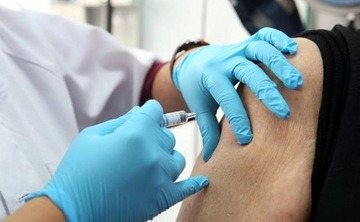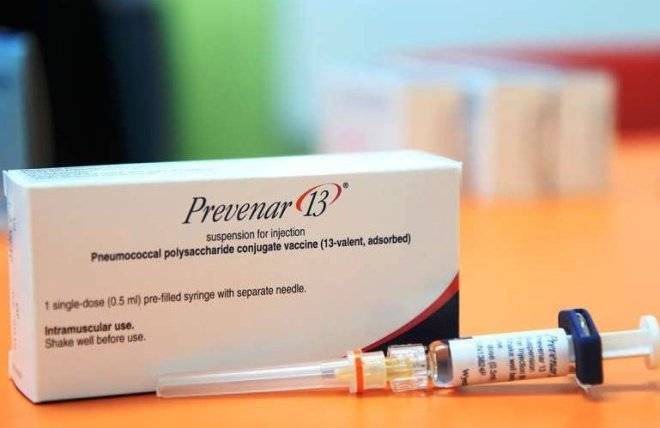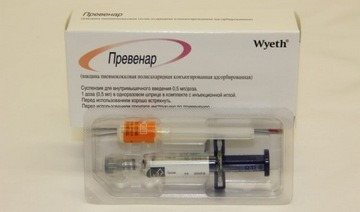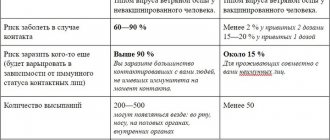In the 90s of the twentieth century, French scientists developed the Pneumo 23 serum for pneumonia. It was introduced into the Russian vaccination calendar 5 years ago. In developed countries, mandatory immunization against such infections is the norm.
This vaccine is designed to prevent pneumococcal infections. After its administration, immunity to 23 types of bacteria Streptococcus pneumoniae is formed.
Description of the drug
The drug is released in the form of a solution for injection in doses of 0.5 ml. Each contains a mixture of 23 common serotypes of Streptococcus pneumoniae that cause streptococcal infections.
Active ingredients:

polysaccharides (serotypes) 1, 2, 3, 4, 5, 8, 14, 20;- 6V, 15V;
- 7F, 12F, 17F, 19F, 22F, 23F, 33F;
- 9N;
- 9V;
- 10A, 11A, 19A;
- 18C.
A colorless, transparent liquid contains 25 mcg of each.
Excipients: sodium chloride, dibasic sodium phosphate, phenol, water for injection.
The vaccine is produced using technology developed by the international pharmaceutical company Sanofi Pasteur, France.
Pneumovax 23 instructions for use
Active substance Vaccine for the prevention of pneumococcal infections Dosage form: Solution for intramuscular and subcutaneous administration.
Composition: One dose (0.5 ml) contains: Active ingredients: Streptococcus pneumoniae polysaccharides (according to the Danish nomenclature, serotypes 1, 2, 3, 4, 5, 6B, 7F, 8, 9N, 9V, 10A, 11A, 12F, 14 , 15B, 17F, 18C, 19A, 19F, 20, 22F, 23F, 33F) 25 μg of each serotype. Excipients: Sodium chloride 4.5 mg, phenol 1.25 mg, water for injection up to 0.5 ml.
Description: Transparent, colorless liquid.
Pharmacotherapeutic group: MIBP vaccine
ICD-10: XXI.Z20-Z29.Z23.8 The need for immunization against another bacterial disease
ATC: J.07.AL Vaccine for the prevention of pneumococcal infection
Pharmacodynamics: Characteristics of the drug The composition of the vaccine Pneumovax® 23 (vaccine for the prevention of pneumococcal infections, polyvalent) includes a mixture of highly purified capsular polysaccharides from the 23 most common and invasive serotypes of Streptococcus pneumoniae. The 23-valent vaccine contains approximately 90% of the serotypes that cause invasive pneumococcal infections in developed and developing countries. According to scientific publications, the most common serotypes in Russia are 3, 6B, 14, 19F and 23F. The serotypes that most often cause invasive drug-resistant pneumococcal disease are 6B, 19F, 19A, 23F. The Pneumovax® 23 vaccine is produced using technology developed in the research laboratories of Merck Sharp and Dohm. Immunological properties Pneumococcal infection is one of the leading causes of death worldwide and one of the leading causes of pneumonia, bacteremia, meningitis and otitis media. Drug-resistant strains of S. pneumoniae are becoming increasingly common in the United States and other regions of the world. In some regions, more than 35% of pneumococcal strains are reported to be resistant to penicillin. Many penicillin-resistant pneumococci are also resistant to other antimicrobials (eg, erythromycin, trimethoprim-sulfamethoxazole, and broad-spectrum cephalosporins), further emphasizing the importance of vaccine prevention of pneumococcal disease. Immunogenicity Purified pneumococcal capsular polysaccharides have been found to induce the production of antibodies that effectively protect against pneumococcal infection. In clinical studies of the polyvalent vaccine, the immunogenicity of each of the 23 types of capsule antigens included in the vaccine was confirmed. Protective levels of antibodies to pneumococcal type-specific capsular antigens usually appear by the third week after vaccination. Bacterial capsular polysaccharides stimulate antibody production primarily through mechanisms that are independent of T lymphocytes. As a result, in children under 2 years of age, whose immune systems are still immature, the immune response to most types of pneumococcal capsular antigens is usually weak or unstable. Duration of Acquired Immunity Following administration of pneumococcal vaccine, serotype-specific antibody levels decline over 5 to 10 years. In some groups of people (for example, children), the decline in antibody levels may occur more quickly. Limited published data indicate that antibody levels may decline more rapidly in older adults (over 60 years of age). These results indicate that booster vaccination may be required to ensure continued protection (see INDICATIONS FOR USE, Revaccination subsection). The CDC Pneumococcal Surveillance System seroprevalence study demonstrated a 57% protective efficacy of vaccination against invasive infections caused by vaccine serotypes in persons over 6 years of age; 65-84% effectiveness in patients of special groups (for example, people with diabetes, coronary heart disease, congestive heart failure, chronic pulmonary disease and anatomical asplenia); and 75% effectiveness in immunocompetent individuals over 65 years of age. Vaccine efficacy has not been confirmed in some groups of immunocompromised patients because sufficient numbers of unvaccinated patients could not be recruited into each disease group. The study results suggest that vaccination may provide protection for at least 9 years from the first dose. Another study demonstrated a decrease in effectiveness with increasing time after vaccination, especially in very elderly individuals (over 85 years of age).
Indications: The Pneumovax® 23 vaccine is intended for the prevention of pneumococcal infection caused by types of pneumococcus, the antigens of which are included in the vaccine. The vaccine is given to people aged 50 years and older, and to people over 2 years of age who are at increased risk of developing pneumococcal infections. Immunocompetent persons: - Routine vaccination of persons aged 50 years and older. - Individuals over 2 years of age who have chronic cardiovascular disease (including congestive heart failure and cardiomyopathy), chronic lung disease (including chronic obstructive pulmonary disease and emphysema), or diabetes mellitus. - Persons over 2 years of age who suffer from alcoholism, chronic liver disease (including cirrhosis of the liver) or leakage of cerebrospinal fluid. - Persons over 2 years of age with functional or anatomical asplenia (including sickle cell disease and splenectomy). — Persons over 2 years of age living in special environmental conditions or special social conditions (including the peoples of the Far North). Immunocompromised persons: - Persons over 2 years of age, including those with HIV infection, leukemia, lymphoma, Hodgkin's disease, multiple myeloma, advanced malignancy, chronic renal failure or nephrotic syndrome, persons receiving immunosuppressive chemotherapy (including corticosteroids), and recipients after bone marrow transplantation or organ transplantation (for patients from special groups, see the “SPECIAL INSTRUCTIONS” section, subsection “Vaccination Timing”). Revaccination - Revaccination with Pneumovax® 23 vaccine is generally not recommended for immunocompetent individuals previously vaccinated with a 23-valent polysaccharide vaccine. — However, a single booster vaccination with Pneumovax® 23 is recommended for persons 2 years of age and older who are at greatest risk of serious pneumococcal infections and those whose anti-pneumococcal antibody levels may decline rapidly, provided that at least five years have passed since since the first dose of pneumococcal vaccine was administered. Those at highest risk for pneumococcal infections include people with functional or anatomical asplenia (for example, those with sickle cell disease or splenectomy), those with HIV infection, leukemia, lymphoma, Hodgkin's disease, multiple myeloma, advanced malignancy, chronic renal disease deficiency, nephrotic syndrome, or other conditions associated with immunosuppression (eg, bone marrow or organ transplantation), and persons receiving immunosuppressive chemotherapy (including long courses of systemic corticosteroids) (see section "SPECIAL INSTRUCTIONS", subsection " Vaccination dates"). - In children 10 years of age and younger who are at high risk for severe pneumococcal infections (for example, children with functional or anatomical asplenia, including sickle cell disease or after splenectomy, or those with conditions associated with a rapid decline in antibody levels after primary vaccination, including nephrotic syndrome, renal failure or after kidney transplantation), revaccination with Pneumovax® 23 may be considered three years after the previous dose of Pneumovax® 23. - If prior vaccination status is unknown, patients at high risk of developing pneumococcal infections should be vaccinated with pneumococcal vaccine. — All persons 65 years of age and older who have not been vaccinated within 5 years (and were under 65 years of age at the time of vaccination) should receive another dose of Pneumovax® 23 vaccine. Since there are three data regarding the safety of pneumococcal vaccine when administered or more times are insufficient, additional vaccination after the second dose of the vaccine is usually not recommended. — For persons 2 years of age and older who are at greatest risk of serious pneumococcal infections and who have previously been vaccinated with pneumococcal conjugate vaccine, booster vaccination with Pneumovax® 23 is recommended. The interval between the administration of pneumococcal conjugate vaccine and the administration of Pneumovax® 23 vaccine should be at least 8 weeks.
Contraindications: - Hypersensitivity to any component of the vaccine. In the event of an acute anaphylactoid reaction to any component of the administered vaccine, a solution of epinephrine (1:1000) should be available for immediate administration. — Severe reaction or post-vaccination complication to a previous injection. — Acute infectious and non-infectious diseases, exacerbation of chronic diseases are temporary contraindications for vaccinations. Routine vaccinations are carried out 2-4 weeks after recovery or during the period of convalescence or remission. For mild acute respiratory viral infections, acute intestinal diseases and other diseases accompanied by a rise in temperature, vaccinations are carried out immediately after the temperature normalizes. - Any febrile respiratory illness or other acute infections is a reason to postpone vaccination with Pneumovax® 23, unless, in the opinion of the doctor, such a delay entails an even greater risk.
With caution: Caution should be exercised when administering the vaccine to persons receiving immunosuppressive therapy, persons with severe forms of cardiovascular and/or pulmonary dysfunction (see section “SPECIAL INSTRUCTIONS”).
Pregnancy and lactation: Not studied.
Directions for use and dosage: FOR INTRAMUSCULAR OR SUBCUTANEOUS ADMINISTRATION ONLY! Do not administer intravenously or intradermally! Before administration, the contents of the vial or syringe are checked for the presence of mechanical particles and color changes. The vaccine Pneumovax® 23 is a clear, colorless liquid. The Pneumovax® 23 vaccine is administered in a volume of 0.5 ml subcutaneously or intramuscularly (preferably into the deltoid muscle or the lateral surface of the mid-thigh), while taking the necessary precautions to avoid intravascular administration. To prevent the transmission of infectious agents from one person to another, it is important to use a separate sterile syringe and needle for each individual patient. No dilution or reconstitution of the drug is required. Administration of the vaccine supplied in the vial The contents of the vial are completely drawn into a syringe that does not contain preservatives, antiseptics or detergents. Administration of the vaccine supplied in a pre-filled syringe The pre-filled syringe is intended for one-time use only. Inject the entire contents of the syringe.
Special groups of patients Children The Pneumovax® 23 vaccine is not used in children under 2 years of age, because children in this age group do not develop an effective immune response to the capsular antigens that are part of the polysaccharide vaccine. Elderly patients Clinical studies of the Pneumovax® 23 vaccine, which included persons aged 65 years and older, were conducted before and after the registration of this drug. In the largest of these studies, the safety of Pneumovax® 23 when administered to adults aged 65 years and older (n = 629) was compared with the safety of Pneumovax® 23 when administered to adults aged 50 to 64 years (n = 379). . Participants in this study were outpatients, and the prevalence of age-related chronic diseases was as expected. Clinical data did not allow us to identify an increased frequency and severity of adverse reactions in people over the age of 65 years compared to those in patients from the group of 50-64 years. However, since the tolerance of older people to medical interventions may not be the same as that of younger patients, a higher frequency and/or greater severity of reactions in some older people cannot be ruled out. Post-marketing reports have been received noting that in some frail elderly people with multiple comorbidities, severe adverse events and worsening of the clinical course of existing diseases occurred after vaccination.
Side effects: The clinical study of the Pneumovax® 23 vaccine involved first-time and revaccinated adult patients, including 379 people aged 50 to 64 years and 629 people aged 65 years and older. The incidence of injection site reactions in first-time and revaccinated patients was 72.8% and 79.6%, respectively, in persons aged 50 to 64 years, and 52.9% and 79.3%, respectively, in persons aged 65 years and older. The incidence of injection site reactions in the older age group of revaccinated subjects was comparable to the frequency observed in the younger age group of revaccinated subjects. Injection site reactions appeared within three days after vaccination and usually disappeared by the fifth day after vaccination. The incidence of systemic reactions in first-time and revaccinated patients was 48.8% and 47.4%, respectively, in persons aged 50 to 64 years, and 32.1% and 39.1%, respectively, in persons aged 65 years and older. The incidence of established vaccine-associated systemic reactions in newly vaccinated and revaccinated patients was 35.5% and 37.5%, respectively, in persons aged 50 to 64 years, and 21.7% and 33.1%, respectively, in persons aged 65 years. years and older. The incidence of systemic and vaccine-associated systemic reactions in the older age group of revaccinated subjects was comparable to the frequency observed in the younger age group of revaccinated subjects. The most common systemic adverse events were asthenia/fatigue, myalgia, and headache. Symptomatic treatment led to complete recovery in most cases. Below are the adverse reactions that were observed during clinical trials and/or in the post-registration period. The frequency of adverse reactions was determined as follows: very often (≥1/10), often (≥1/100, but <1/10), infrequently (≥1/1000, but <1/100), rarely (≥1/10000 , but <1/1000), very rare (<1/10000), unknown (the frequency of these adverse reactions cannot be determined from the available data, since they were obtained voluntarily from a population of unknown size). Blood and lymphatic system disorders Not known: hemolytic anemia*, leukocytosis, lymphadenitis, lymphadenopathy, thrombocytopenia**. Immune system disorders Not known: anaphylactoid reactions, Quincke's edema, serum sickness. Nervous system disorders Not known: febrile seizures, Guillain-Barré syndrome, headache, paresthesia, radiculoneuropathy. Gastrointestinal disorders Unknown: nausea, vomiting. Skin and subcutaneous tissue disorders Unknown: rash, urticaria, erythema multiforme. Musculoskeletal and connective tissue disorders Not known: arthralgia, arthritis, myalgia. General disorders and administration site conditions Very common: fever (< 38.8°C) and the following injection site reactions: erythema, local induration, pain, tenderness, swelling, warmth. Rarely: cellulitis at the injection site†. Not known: asthenia, chills, fever, decreased mobility of the injected limb, malaise, peripheral edema††. Laboratory and instrumental data Unknown: increased levels of C-reactive protein. * in patients who had other hematological diseases; ** in patients with stabilized idiopathic thrombocytopenic purpura; †with rapid appearance after vaccine administration; †† the limb in which the injection was given.
Overdose: There are no data on cases of overdose.
Interactions: Use with other vaccines Pneumococcal vaccine may be given at the same time as the influenza vaccine (given in the other arm). Such administration does not lead to an increase in the frequency of side effects or a decrease in the intensity of the immune response to the administration of each of the vaccines. The pneumococcal vaccine can be administered simultaneously (on the same day) with other vaccines (except for vaccines to prevent tuberculosis) in different parts of the body using different syringes. (Information on the interval between the administration of the conjugate pneumococcal vaccine and the administration of the Pneumovax® 23 vaccine is presented in the “Indications for use” section, subsection “Re-vaccination”).
Special instructions: Vaccination using the Pneumovax® 23 vaccine will not protect against diseases caused by pneumococci of those capsular types that are not included in this vaccine. If the Pneumovax® 23 vaccine is administered to persons receiving immunosuppressive therapy, the level of serum antibodies may be lower than expected and there may be an insufficient immune response to pneumococcal antigens (see subsection “Timing of vaccination”). Intradermal administration may cause severe local adverse reactions. As with any vaccine, vaccination with Pneumovax® 23 may not result in complete protection for all vaccinated individuals. Vaccination with Pneumovax® 23 may not be effective in preventing infection resulting from a fracture of the base of the skull or leakage of cerebrospinal fluid into the external environment. In patients whose condition requires penicillin (or other antibiotics) to prevent pneumococcal infection, such prophylaxis should not be discontinued after vaccination with Pneumovax® 23. Particular care and appropriate precautions should be taken when administering Pneumovax® 23 to persons with severe forms of impairment cardiovascular and/or pulmonary functions.
Timing of vaccination For some diseases, the pneumococcal vaccine must be administered at least two weeks before the planned splenectomy. When planning cancer chemotherapy or other immunosuppressive therapy options (for example, in patients with Hodgkin's disease or those undergoing bone marrow or organ transplantation), the interval between vaccination and the start of immunosuppressive therapy should be at least two weeks. Vaccination during chemotherapy or radiation therapy should be avoided. The pneumococcal vaccine can be administered several months after completion of chemotherapy or radiation therapy for tumor diseases. In Hodgkin's disease, after intensive chemotherapy (with or without radiation therapy), the immune response to vaccination may be reduced for two years or more. Some patients experience significant improvement in their immune response within two years of completing chemotherapy or other immunosuppressive therapy (with or without radiation), especially as the interval between the end of treatment and pneumococcal vaccine administration increases. Persons with asymptomatic or clinically evident HIV infection should be vaccinated as soon as possible after diagnosis.
Impact on the ability to drive vehicles. Wed and mech.: The effect of the vaccine on the ability to drive vehicles and operate machinery has not been studied.
Release form/dosage: Solution for intramuscular and subcutaneous administration, 1 dose.
Packaging: 0.5 ml (1 dose) in a clear glass bottle with a capacity of 3 ml. The bottle is sealed with a silicone-coated bromobutyl stopper, under an aluminum trim and closed with a snap-on plastic cap with tamper-evident control. 1 bottle of vaccine is placed in a cardboard box with instructions for medical use. 0.5 ml (1 dose) in a disposable syringe with a capacity of 1.5 ml made of type I glass with a Luer-Lock adapter, a protective styrene-butadiene cap connected to a plastic cap, and a piston covered with a bromobutyl stopper. 1 disposable syringe with a stainless steel needle (or without a needle), placed in a contour package. 1 contour package is placed in a cardboard box with instructions for use. 10 blister packs are placed in a cardboard pack with instructions for medical use.
Storage conditions: Store at a temperature of 2 to 8 °C, protected from light. Keep out of the reach of children.
Shelf life: 2 years. Do not use after the expiration date stated on the packaging.
Conditions for dispensing from pharmacies: By prescription
Disease Prevention
The Pneumo 23 vaccine protects against many diseases caused by streptococcal infection. All of them cause serious complications and are dangerous not only to health, but also to human life.
Vaccinations help prevent the following diseases:

pneumonia;- bronchitis;
- meningitis;
- otitis;
- sepsis.
The use of the vaccine, even once, forms stable specific immunity to bacteria of the genus Streptococcus pneumoniae.
What diseases does it protect against: indications for use

The indication for use of the Pneumo23 vaccine, shown in the instructions for the drug, is the prevention of pneumococcal infections of any location:
- in the bronchi - bronchitis;
- in the lungs - pneumonia;
- in the middle ear - otitis media;
- in the membranes of the brain - meningitis;
- generalized - septicemia.
The polyvalent vaccine Pneumo23 is intended for categories of people most at risk of infection with pneumococci:
- often suffer from inflammatory diseases of the upper respiratory tract, sinuses and middle ear;
- repeatedly undergoing courses of antibiotic therapy;
- attending nurseries, kindergartens and schools;
- those raised in large families;
- living in shelters, boarding schools, nursing homes;
- suffering from chronic pathologies of the immune, bronchopulmonary, circulatory, digestive, endocrine or genitourinary systems.
Patient age
Vaccination is given to children over 2 years of age and adults. Immunization is also indicated for elderly people over 65 years of age with weakened immunity (chronic bronchitis, diabetes, heart failure).

Vaccination of children
Before administering the drug, the pediatrician examines the child. It is important to get an appointment with a family doctor who knows about all the diseases and developmental features of the baby.
At the time of vaccination, the small patient must be completely healthy (normal body temperature, no nasal discharge, cough, rash). At least 1 month must have passed since the previous illness.

The medical professional is obliged to inform parents about the possible consequences and complications after the injection.
After the administration of the serum, parents and the child do not leave the hospital for half an hour. If an allergic reaction does not appear, after consulting a doctor, you can go home.
Vaccination of adults
At the time of visiting the doctor, the patient must be completely healthy. If chronic diseases have worsened, you should notify your doctor. Weakness, elevated body temperature, allergic reactions are contraindications for vaccination.
The drug is administered to adults intramuscularly or subcutaneously. Intravenous administration is prohibited. The dose of the drug for primary immunization is 0.5 ml.
After the vaccine is injected, the patient remains in the medical facility for at least 30 minutes. In case of acute allergic reactions, a complex of anti-shock actions is carried out.

The effect of the vaccine against pneumococcal infection
Today in our country, vaccination against pneumococcal infection is done by introducing into the body high-quality vaccines Prevenar-13 and Pneumo-23. Both immune drugs are reliable and effective.
Among the positive qualities of vaccines, immunologists highlight:
- rapid formation of a protective reaction against pneumococci in the patient;
- low percentage of post-vaccination adverse reactions and complications;
- minimum number of contraindications.
Vaccines against pneumococcal infection are poorly accepted by children with weakened immune systems, and therefore do not guarantee full protection against dangerous pathogens.
But after vaccination, the baby’s parents can be sure that even if the child gets sick. He will definitely survive the disease in a mild form and without any complications. The Prevenar vaccine is intended for vaccination of infants starting from two months after their birth.
This suspension contains 13 pneumococcal conjugates, which allow the formation of a sufficient immune response to infections. To develop immunity, the solution must be administered four times. Parents are warned that after vaccination, the baby may experience reactions to the vaccine, since it is a foreign material for him.
Vaccine Prevenar-13
The most common symptoms observed in young children after vaccination with Prevenar are:
- increase in general body temperature to 37.5 C;
- redness and slight swelling at the site of injection of the solution;
- lack of appetite on the day of the procedure;
- drowsiness and tearfulness after immunization.
As a rule, such changes go away on their own within 2-3 days and do not require drug correction. They do not pose a threat to the child’s health and are normal reactions of his body to the introduction of biological material.
The Pneumo-23 vaccine is used in children after two years of age and in adult patients. It consists of 23 serotypes of pneumococci, therefore it is considered one of the most effective suspensions for the prevention of pneumonia and bronchitis. To produce immune complexes, one injection of the drug is sufficient. The vaccinated immunity lasts for five years.
Vaccine Pneumo-23
Pneumo-23 has a number of advantages:
- the vaccine is harmless, confirmed by many years of research on the drug;
- the vaccine is produced in a disposable syringe with a needle, which minimizes the risks of developing local post-vaccination complications and introducing infections that are transmitted by transmission;
- the solution can be administered along with influenza vaccines.
Despite all the positive qualities of modern vaccines against pneumococcal infection, their use in rare cases may be accompanied by consequences. The risk of complications after vaccination is minimal, mainly for patients with impaired immune system function.
Preparing for vaccination
14 days before the date of vaccination (expected), a blood test is taken to detect hidden infections. If your health is not a concern, you can refuse the procedure.
A few days before vaccination, it is better to avoid visiting public places to avoid contracting a viral infection. If you are surrounded by sick people, it is better to avoid their company 3-4 days before and after vaccination.
During this period, avoid foods that cause allergies. A few days before and after vaccination, allergy sufferers are advised to take antihistamines.
Vaccination may not be combined with certain types of medications. Before administering the vaccine, the doctor is notified of the treatment being taken and given a list of medications used.
Vaccination scheme

The substance is contained in the syringe in finished form. Before use, remove the product from the refrigerator and leave at room temperature for several minutes. Then it is printed and used for its intended purpose.
At the first administration, a dosage of 0.5 ml is prescribed. A detailed vaccination schedule with Pneumo 23 is determined by the doctor.
Can be used in conjunction with influenza vaccines.
A specific immune response develops 14–21 days after vaccination.
Compatibility with other vaccines
The pneumococcal vaccine Pneumovax 23 can be given at the same time as the flu vaccine (which is given in the other arm). Such administration does not lead to an increase in the frequency of side effects or a decrease in the intensity of the immune response to the administration of each of the vaccines.
The pneumococcal vaccine can be administered simultaneously (on the same day) with other vaccines (except for vaccines to prevent tuberculosis) in different parts of the body using different syringes.
The Pneumovax 23 vaccine can be administered no earlier than 4 weeks after Zostavax vaccination.
Validity
After primary immunization, persistent protection against streptococcal infection develops for 3 years.
After the specified time, revaccination is carried out in order to form the body’s resistance to the effects of Streptococcus pneumoniae.
Repeated vaccination

For repeated vaccination, 1 dose of serum (0.5 ml) is prescribed. For patients with reduced immunity and an increased risk of contracting pneumococcal infection, repeated administration of the vaccine is prescribed after 2 years.
If revaccination is carried out earlier than the due date, serious allergic reactions may develop.
At what age are children vaccinated?
Pediatricians recommend the polyvariant vaccine Pneumo23 for use in children over two years of age.
The main disadvantage of this product is the age limit - for children under two years old. After all, the younger the child who is vaccinated against pneumococci, the more effective the result is.
They are especially advised to vaccinate those who were born before 2015 and did not receive free anti-pneumococcal immunization as part of the Russian vaccination calendar.
Most experts are of the opinion that in six-year-old children who are not at risk for pneumococcal infection, immunity has already been sufficiently developed and administration of the vaccine is not indicated for them.
Painful sensations in a child
The administration of a vaccine to a child may be associated with severe pain. The reason is the buffer components of the vaccine, which complement the main active ingredient.
Complications are caused by a small amount of aluminum, which is contained in almost every serum.

After vaccination, children may experience undesirable consequences: pain in the leg, redness, swelling, fever up to +38 ° C. This reaction is considered normal.
Unpleasant symptoms go away on their own after a few days.
The first day after the procedure, the puncture site should not be wet. If it is swollen, the child is given antihistamines in a dosage appropriate to his age, strictly according to the instructions.
In case of severe pain, the baby is given drugs based on paracetamol or ibuprofen in an age-appropriate dosage.
The appearance of severe pain, an increase in temperature to +39 ° C, the presence of suppuration at the injection site is a reason to consult a pediatrician.
Arm pain
Pneumo 23 is quite well tolerated by patients. In rare cases, the following side effects can be observed:

redness;- swelling;
- pain at the injection site;
- slight increase in temperature;
- weakness.
Painful sensations and swelling of the muscle near the shoulder are an immune reaction to the administration of the drug. If the pain is severe, take painkillers.
Antipyretic medications are not recommended for adults. This reduces the immune response to the injected drug.
Pain, fever, and weakness should go away within 5 days. The seal may persist for a longer period of time. If painful symptoms do not disappear within several days, consult a doctor.
How to behave after vaccination

In general terms, your behavior shouldn't be much different. It is only worth noting that after the injection you should stay at the clinic and be under the supervision of doctors for 30 minutes. Such precaution is necessary if, upon the occurrence of any pathological reactions, emergency medical measures were taken to the person in a timely manner.
On this day, it is also undesirable to carry out water procedures, visit the pool or sauna. The injection site should not be combed, rubbed, or lubricated with ointments. The daily routine, nutrition, and rest may be left unchanged.
How is it transferred
Most patients do not experience any painful conditions after vaccination with Pneumo 23. Sometimes you may experience sensitivity at the injection site or an allergy to the components of the drug.
Possible complications

The complication develops on the day of vaccination and lasts no more than a day. The development of adenopathy (enlarged lymph nodes), joint pain, and urticaria is rarely observed. In these cases, emergency medical attention is required.
Consequences
Pneumo 23 is well tolerated by patients. In some cases, after administration of the vaccine, hyperthermia (fever), chills, and headache develop.
Induration and swelling appear at the injection site, and the patient feels pain. These symptoms go away on their own within a few days.
Prevenar and Pneumo-23: differences in the reaction to vaccination
For many patients, especially for parents choosing a drug for vaccination, the reaction to vaccination is of great importance. It should be taken into account that it is not always the drug that matters; the characteristics of the body are also important. In addition, immunization rules must be followed. The vaccine must be stored in an appropriate place, at a certain temperature.
Reactions to Prevenar and Pneumo-23 are practically the same. These include:
- local reaction in the injection area;
- hyperthermia up to 39 degrees;
- weakness, irritability, loss of appetite;
- allergic reactions of varying severity - from slight redness to Quincke's edema;
- after Prevenar, there is often pain in the limb where the vaccine was given, the appearance of convulsions, vomiting, and enlarged lymph nodes have been reported;
- After Pneumo, there were complaints of pain in the joints and exacerbation of chronic pathologies.

Contraindications
Pneumo 23 is not administered to certain groups of people. These are patients prone to developing a hypersensitivity reaction.
Also, the drug is not given in the following cases:

pregnancy (first and second trimester);- presence of ARVI;
- chronic diseases (in the acute stage);
- increased body temperature;
- if less than 3 years have passed since the previous vaccination.
A recent pneumococcal infection is not a contraindication to the vaccine.
Analogues of the drug

Prevenar is a drug produced in the UK. It contains 13 strains of pneumococcus. The vaccine is registered in 90 countries. It is administered to children from six months to 2 years.
Synflorix is a Belgian drug. It contains 10 strains of bacteria. It has been used in the world for no more than 5 years.










